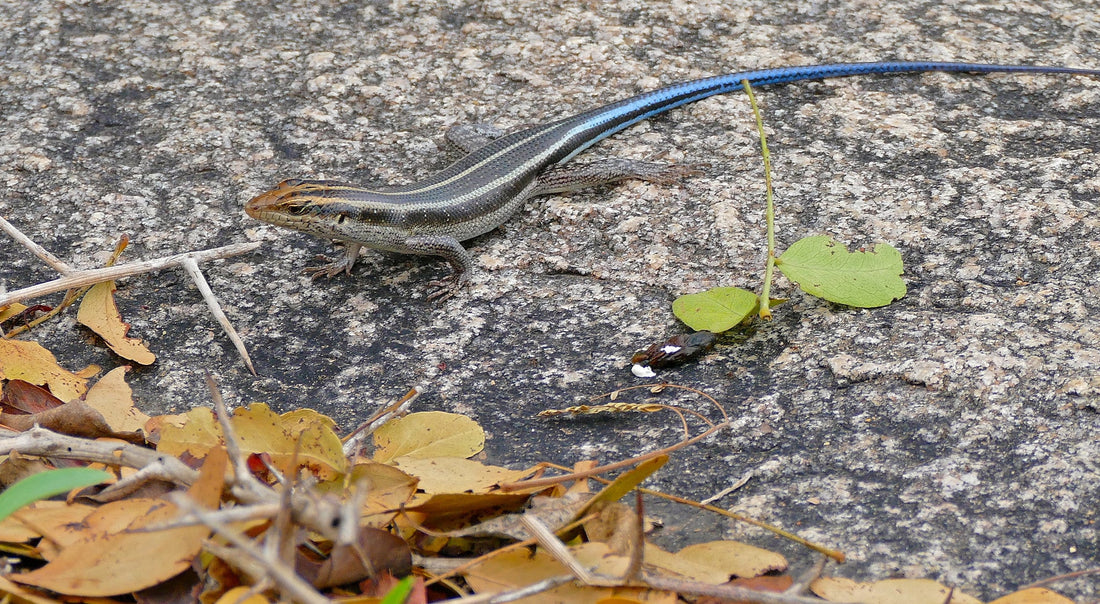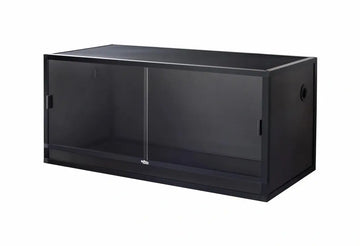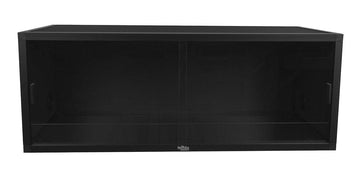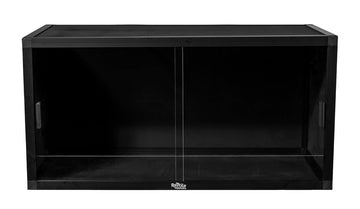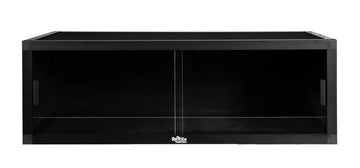The rainbow skink (Trachylepis quinquetaeniata) is also known as the rainbow mabuya or the African five-lined skink. It is a 8” long, diurnal lizard native to equatorial Africa, although invasive populations are present in the United States. They can be found in a variety of habitats, including savannah, scrub, and deciduous forest.
Rainbow skinks have a small tapered head, dark eyes, an elongated body, short limbs, and a long, thin tail. Males and females look very different from one another: males are light to dark brown, with a dark throat, yellow to orange stripes down the length of the body, and silver to blue spots on the throat and sides. Females and juveniles have a dark brown to black base color with golden stripes and a blue tail.
Rainbow skinks are not very tame pets, but they can make an entertaining display species.
Minimum terrarium size for rainbow skinks
Due to their diminutive size, the minimum terrarium size for a rainbow skink is 24”L x 18”W x 18”H. Of course, these are quite active lizards, so larger is always better — if you provide, they will absolutely use it!
Housing multiple rainbow skinks in the same terrarium is not necessary, and should not be done unless you intend to breed them. A breeding group of one male and two females can be housed in a 48” x 24” x 24” enclosure.
Do rainbow skinks need UVB?
Rainbow skinks require high-quality UVB lighting as part of their setup in order to stay healthy in captivity. UVB lighting helps provide a clear day/night cycle, provides all of the vitamin D that your pet needs, strengthens the immune system, facilitates better digestion, and provides other benefits.
The best UVB bulbs for rainbow skinks are:
- Zoo Med Reptisun T5 HO 5.0, 22”
- Arcadia Forest 6%, 22”
For best results, house the UVB bulbs in a reflective fixture, preferably Arcadia or Vivarium Electronics. Position the lamp on the same side of the terrarium as the heat lamp. If the lamp is positioned over mesh, the basking area should be placed 7-9” below for best results. If there is no mesh obstruction, increase the distance to 11-12”.
UVB is blocked by glass and plastic, so placing the terrarium in front of a window doesn’t count as “free UVB” — in fact it can make your terrarium too hot due to the greenhouse effect. And don’t forget to replace your bulb every 12 months!
Lights and heating should be on for 13 hours/day during summer and 11 hours/day during winter. Alternatively, you can use a smart timer to sync your lamps with local sunrise and sunset times.
Best temperature for rainbow skinks
Rainbow skinks should have a basking area temperature between 90-95°F. The cool side temperature should stay between 75-85°F, and heat sources should be turned off at night. Temperatures may safely drop down as low as 68°F.
Provide heat for your skink with a 50w incandescent heat lamp in order to help replicate sunlight. Do not use ceramic heat emitters (CHEs), red bulbs, or blue bulbs, as these are not as effective. If temperatures get too warm, use a lamp dimmer or rheostat to reduce the bulb’s output. If your basking temperature is too cool, increase the wattage of the bulb you are using.
For best results, use a large flat stone (ex: flagstone, paver stone, slate tile) as the basking surface. Measure temperatures with a digital probe thermometer with the probe placed on the basking surface.
Best humidity levels for rainbow skinks
Rainbow skinks need average humidity levels between 60-80%. Measure the average humidity in your skink’s enclosure with a digital probe hygrometer, with the probe placed in the middle of the terrarium. Humidity levels should fluctuate lower during the day and higher at night.
You can maintain appropriate humidity levels by mixing water into the substrate, misting with a spray bottle, and providing a humid hideout lined with moistened sphagnum moss.
Best substrate for rainbow skinks
“Loose” substrates that mimic a reptile’s natural environment present a low impaction risk, cushion the animal’s joints, and offer a place where they can exercise natural burrowing behaviors. These substrates also help maintain correct humidity levels.
We recommend the following substrates for rainbow skinks:
- Zoo Med Eco Earth
- Zoo Med ReptiSoil
- Exo Terra Plantation Soil
- Zilla Jungle Mix
Alternatively, you can mix your own rainbow skink substrate with 60% topsoil or coconut fiber and 40% sand. Layering clean, chemical-free leaf litter on top of the substrate can also help with humidity.
Substrate should be around 3” deep and completely replaced every 3-4 months. Remove poop and urates daily, along with contaminated substrate.
How to decorate a rainbow skink terrarium
An empty terrarium leads to a bored skink. Keep your pet entertained and engaged with its environment with the strategic use of decor items that encourage it to exercise natural behaviors.
At bare minimum, you will need at least two hiding places for the skink to use. However, it’s best to include other items, such as:
- hollow logs
- cork flats
- branches
- ledges
- live or artificial plants
- misc. ornaments
- textured background
What to feed to a rainbow skink
Rainbow skinks are insectivores, which means that they need mostly animal-based foods in their diet. Offer food daily, as many insects as your skink is capable of eating in roughly 5 minutes. If the skink seems to be gaining weight, offer less food. If they seem to be losing weight, offer more food. The key to balanced nutrition is variety, so make sure your skink gets as many different types of insects as possible!
Insects for rainbow skinks: dubias, discoids, red head roaches, crickets, mealworms, hornworms, silkworms, snails, black soldier fly larvae
Supplements
You will also need calcium and vitamin supplements to help keep your skink healthy. We recommend Repashy Calcium Plus LoD, lightly dusted on all of your skink’s feeder insects and organ or muscle meats. It’s okay to occasionally skip a dusting.
Water
Of course, don’t forget a small water bowl for your skink to drink from and soak in! Change the water daily and scrub the bowl with a reptile-safe disinfectant weekly, or whenever it becomes soiled.
How to handle your rainbow skink
Reptiles generally don’t appreciate petting and handling in the same way that dogs and cats do. Rainbow skinks are one of the types of reptiles that usually prefer to be left alone rather than handled regularly, although there are exceptions. One of the best ways to interact with your pet is to hand-feed it with a pair of feeding tweezers.
*This care sheet contains only very basic information. Although it’s a good introduction, please further your research with high-quality sources. The more you know, the better you will be able to care for your pet!
"Rainbow Skink (Trachylepis quinquetaeniata) juvenile ..." by berniedup is licensed under CC BY-SA 2.0.

